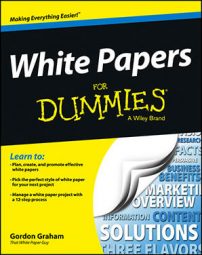This step is a well-understood part of any publishing process. After the writer creates a first draft of the white paper and the illustrator creates the graphics, the reviewers need to comment. And the client has to manage the reviews to make sure they happen in a timely and constructive way. This process must be handled with patience, tact, and sometimes a dash of good-natured humor from everyone.
| Step | Who | What |
|---|---|---|
| 7.1 | Client | Circulates first-draft text and graphics to reviewers with deadline for comments |
| 7.2 | Reviewers | Comment on first-draft text and graphics |
| 7.3 | Client | Gathers all comments and resolves any differences |
| 7.4 | Client | Sends comments on text to writer |
| 7.5 | Client | Sends comments on graphics to illustrator |
What the client does to gather comments for the white paper
The client circulates the first-draft text and graphics to all reviewers with a request to get their comments back by the appointed deadline. To set the deadline, the client checks the schedule and gives a realistic review period.
A week is about right for a first-draft white paper; never allow more than two weeks, or the project can lose momentum with team members.
Help your reviewers understand that you value their time and will consider each of their comments carefully, but they should keep the ideal reader and purpose of the document in mind rather than their personal preferences. As they go through a draft, every reviewer should ask, “How will the ideal reader react to this? How well will this help us achieve our purpose?”
As the comments come in, the client reviews them to make sure they make sense and don’t contradict one another. The client clarifies any comments that are unclear, contradictory, or destructive, or else discards them outright. Finally, the client sends all useful comments on the text to the writer and all useful comments on the graphics to the illustrator.
How to deal with comments on the first draft of the white paper
Very few reviewers understand the different levels of editing; many feel that their role is to work at the worm’s-eye view of the text simply to check the spelling and grammar of the draft. Because Word can check spelling and grammar fairly well, tell your reviewers that you want them to focus on the bird’s-eye view to make sure the white paper makes valid points and fulfills the desired purpose.
Even so, you can expect most of the comments to focus on individual words, phrases, and sentences. The good news is that these rules drummed into people’s heads in grade school aren’t absolute. The bad news is that these sticklers may be powerful executives in the company who insist on reviewing for this kind of banal detail.
An ideal reviewer sticks to the higher level, correcting technical details, shading the text to reflect company or product positioning, and perhaps suggesting more or less coverage of some particular area. If you find a reviewer who consistently provides this kind of useful, to-the-point comments, include him in all your future white paper projects.
You shouldn’t see any sweeping comments suggesting that you make a big departure from the approved outline or include any new material that clearly doesn’t belong to a white paper of the chosen flavor. If you find a reviewer who consistently suggests that you expand the content in all different directions, or go into many side issues, he may be a scope-creep.

